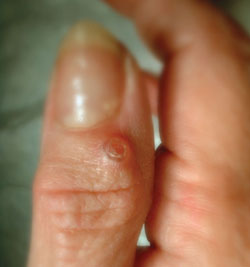 What is it?
What is it?
Ganglion cysts are common and appear as lumps on the hand and wrist near joints or tendons.
What are the symptoms?
They are most often seen on the top and underside of the wrist, the base of the palm side of the finger, and the top of the last joint on the finger. They usually look like water balloons as they are filled with clear fluid.
What are the causes?
 Although the cause of the cysts is unknown, we know they may form when there is also irritation of the joint or tendon. Patients of all ages can have Ganglion cysts. They can be painful, but that isn’t always the case. Their size may change, or they can completely go away. This type of cyst is not painful and does not spread to other areas.
Although the cause of the cysts is unknown, we know they may form when there is also irritation of the joint or tendon. Patients of all ages can have Ganglion cysts. They can be painful, but that isn’t always the case. Their size may change, or they can completely go away. This type of cyst is not painful and does not spread to other areas.
How do we diagnose it?
Diagnosis is often based on the location and appearance of the cyst. Usually oval or round in shape, they can vary in firmness. Generally the ones on the finger base or palm side are firm and pea-sized that may feel tender when pressure is applied. They are usually light-permeable, which helps in the diagnosis. We may order an x-ray so that we can check for problems on nearby joints.
How is it treated?
 Non-surgical options are usually effective. If there is no pain associated with the cyst, you may just want to let it disappear on its own. If, however, it becomes painful or impedes hand movement, there are several ways to treat it. Splints or anti-inflammatory medicine can be used for pain. Additionally, we can aspirate, or remove fluid with a needle, which can be easily done in a doctor’s office. With aspiration, however, recurrence of the cyst is common. When non-surgical treatments don’t work, there are surgical options, which involve removing both the cyst and a part of the joint capsule or tendon covering.
Non-surgical options are usually effective. If there is no pain associated with the cyst, you may just want to let it disappear on its own. If, however, it becomes painful or impedes hand movement, there are several ways to treat it. Splints or anti-inflammatory medicine can be used for pain. Additionally, we can aspirate, or remove fluid with a needle, which can be easily done in a doctor’s office. With aspiration, however, recurrence of the cyst is common. When non-surgical treatments don’t work, there are surgical options, which involve removing both the cyst and a part of the joint capsule or tendon covering.


